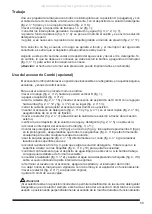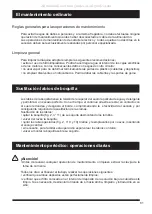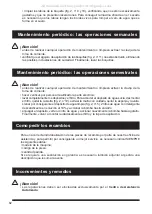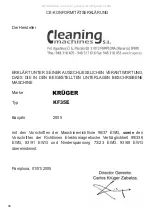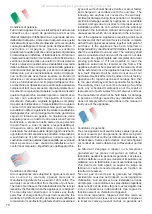
58
ATENCIÓN: APAGAR INMEDIATAMENTE LA ASPIRACIÓN CUANDO LA VÁLVULA
FLOTANTE INTERVIENE.
Descarga de agua limpia
Para proceder a la descarga del depósito de agua limpia:
acercar la parte anterior de la máquina para la descarga;
insertar en el ataque rápido de la máquina (fig. 2, n° 16) el racor especial de vaciado (fig. 2,
n° 20);
mover el selector (fig. 2, n° 7) hacia el ataque rápido;
accionar el interruptor del accesorio Combi (fig. 3, nº 1) hasta el vaciado del depósito;
cuando ya no sale más agua, parar inmediatamente el interruptor del accesorio, quitar el
racor de vaciado y llevar el selector (fig. 2, n° 7) a la posición original.
Montaje y cambio del cepillo cilíndrico
Para montar el cepillo cilíndrico:
desconectar la clavija de la toma de corriente;
arrodillarse cerca del lado anterior derecho de la fregadora;
alzar con una mano la parte anterior de la fregadora;
con la otra mano insertar el cepillo (fig. 2, n° 8) en el centro y apretar hacia arriba hasta que
quede fijo en la posición;
bajar la fregadora.
Para desmontar el cepillo:
desconectar la clavija de la toma de corriente;
llevar el mango a la posición de reposo R (ver fig. 1);
apretar con el pie en el pivote del cepillo (fig. 2, n° 8) y al mismo tiempo empujar hacia atrás
en el mango para alzar la parte anterior de la máquina;
el cepillo caerá a tierra;
desmontar el cepillo de la máquina.
Regulación de las boquillas
Las boquillas, (fig. 2 n° 9, 10 y 11) son las principales responsables del secado. La máquina
está dotado de dos boquillas para lavar y secar, ya sea hacia delante o marcha atrás. Las
boquillas están dotadas de regulación de presión para adaptarlas a todo tipo de superficies.
La regulación se efectúa girando el regulador de presión (fig. 2, n° 17):
en el sentido horario se aumenta la presión;
en el sentido antihorario disminuye la presión.
Preparación de la máquina para el trabajo
Alzar y quitar las tapas de los depósitos (fig. 2, n° 4 y 18);
vaciar, si es necesario, el depósito de recuperación (fig. 2, n° 6) según se indica en el
procedimiento ya descrito (ver el párrafo "descarga de agua sucia");
limpiar, donde sea necesario, el depósito de la solución detergente (fig. 2, n° 5);
llenar el depósito de la solución con una mezcla adecuada de agua y detergente
(
atención
: efectuar esta maniobra verificando siempre que el depósito de recuperación ha
sido completamente vaciado; el hecho de no seguir esta norma puede implicar daños al
motor
de aspiración);
cerrar los dos depósitos con sus correspondientes tapas, asegurándose que el depósito
de recuperación (fig. 2, n° 18) encaja perfectamente.
23
Using the appliance
When the appliance is ready for use, all the switches must be in the O (off) position, the power
supply cable must be connected to the mains power supply, the detergent solution tank (fig.
2, no. 5) must be full and the roller brush (fig. 2, no. 8) assembled:
place the hand piece in the L1 or L2 work position (fig. 1);
switch on the main, vacuum and water switches (fig. 3, no. 2, 3 and 7);
press the trigger down completely (fig. 3, no. 4): the roller brush starts turning and the detergent
solution is spread over the floor;
if necessary, adjust the squeegee pressure by acting on the relative knob (fig. 2, no. 17).
If the solution does not flow when the trigger is pressed down and the water switch is enabled,
this means that the tank is empty.
At this point empty the dirty water tank and fill the detergent tank. However, if it is necessary
to continue cleaning the floor, switch off the switch (fig. 3, no. 3) to exclude the pump to prevent
it from running without water.
Warning:
failure to observe this precaution may damage the pump.
Using the (optional) Combi accessory
The Combi accessory allows the scrubber-drier to clean inaccessible areas such as corners,
stairs and cluttered floor spaces.
To use the Combi, proceed as follows:
place the hand piece (fig. 2, no. 2) in the vertical R position (fig. 1);
switch off the vacuum (pushbutton 2, fig. 3);
lift the flap (fig. 2, no. 15) and insert the Combi vacuum connection into its housing (fig. 2, no.
13) with the hole facing upwards (fig. 2, no. 12 and fig. 4, no. 2);
close the flap on the Combi connection to lock into position;
insert the detergent connection (fig. 2, no. 14 and fig. 4, no. 1) into the snap-in coupling (fig.2,
no. 16); make sure you hear it snap meaning it is firmly secured;
move the selector (fig. 2, no. 7) to allow the solution to flow through the external accessory;
make sure that the water and detergent solution tank (fig. 2, no. 5) is not empty;
act on the Combi switch (pushbutton 1, fig. 3);
assemble extensions 5 and 8 (fig. 4) on the hand piece 4 (fig .4) and the floor intake 9 (fig.4)
on the extension, making sure that all the couplings (fig. 4, no. 8) are firmly secured to prevent
any solution from leaking;
use the small intake (fig. 4, no. 10) directly on the hand piece (fig. 4, no. 4) to wash any soft
surfaces;
grip the accessory, spray the detergent solution by acting on lever 6 in fig. 4, rub the floor or
surface with the intakes (fig. 4, no. 9 and 10) to remove any dirt;
continually check that the clean water tank is not empty: using the pump when there is no
water may cause irreparable damage;
switch on the vacuum (pushbutton 2, fig. 3) and vacuum the dirty water by passing the rubber
part of the squeegee (fig. 4, no. 9) over the floor;
when you have finished using the Combi, always switch off the vacuum and Combi switches.
never leave the appliance unattended while the pump and/or vacuum are running.
place the selector (fig. 2, no. 7) in its original position;
disconnect the Combi from its couplings.
Warning:
The detergent solution will not flow if the selector is not in the correct position! Always make
sure that the selector is positioned so that it faces the Combi pipe when using the Combi
All manuals and user guides at all-guides.com
















